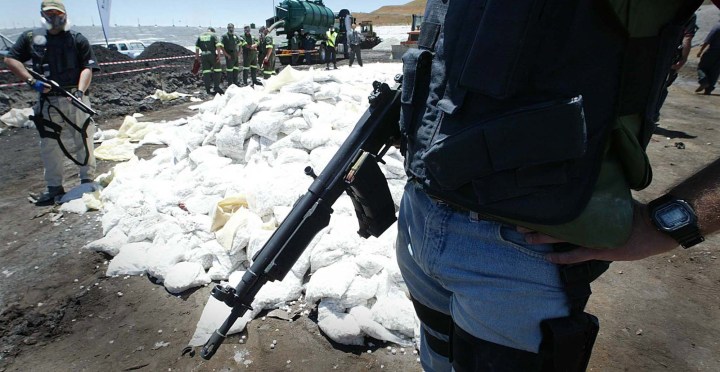MAVERICK CITIZEN OP-ED
Drug markets: A new strategy on collecting pricing data aims to improve this critical evidence base

Data on drug prices have real-world impact. In several countries in east and southern Africa, the estimated value of drugs can directly affect the sentencing of offenders. Price data can also give an insight into how drug markets work. But such data are not often widely available and the methods used to generate them leave much to be desired.
The Global Initiative Against Transnational Organised Crime (GI-TOC) has been developing a new method of conducting drug-pricing surveys that involves people who use drugs. This method responds to calls by drug users and civil society organisations for these people to be meaningfully involved in drug research and policymaking.
Drug prices are some of the most widely used pieces of data about illegal drug markets. Almost any reporting and analysis on drug markets contains some estimate of the value of that particular market, and drug seizures by police are widely reported with estimates of their value. Price data are useful for journalists and analysts seeking to explain the drug trade and its impacts to their readers, for law enforcement and for researchers seeking to understand the drug market. It can have a real-world impact on the sentencing and prosecution of drug offences.
However, up-to-date and publicly available data on drug prices are scarce, and the methods used to collect this data also may present issues. GI-TOC has been developing strategies to collect data on illicit economies, including drug prices, which aim to take a different approach to improving this critical evidence base.
Drug pricing data in the courtroom
In at least three countries in east and southern Africa, the value of drugs has a direct impact on the classification of a criminal offence or on sentencing. Similar measures are in place elsewhere, such as Slovakia and Ireland.
In South Africa, sentencing guidelines view the value of drugs as an aggravating factor when the value of the drugs involved is more than R50,000, or R10,000 if the offence is committed by a criminal group.
In Mauritius, under the Dangerous Drugs Act 2000, an offender is charged as a “trafficker” when the street value of the drugs exceeds 1 million Mauritian rupees (R370,498).
Uganda’s Narcotic Drugs and Psychotropic Substances (Control) Act 2016 likewise prescribes penalties based on drug value in possession cases. In addition to imprisonment, the act prescribes fines of 10 million Ugandan shillings (R40,732) or three times the market value of the drug, whichever is greater. The act prescribes the same fine in cases of trafficking, in addition to life imprisonment.
Interestingly, the Ugandan legislation states that the market value of the drug in question has to be certified by the proper officer of the court, and the certificate presented as a prima facie piece of evidence at trial. At least as recently as December 2019, this provision was creating problems in Uganda’s courts, particularly in cases where drugs were being trafficked through the country, due to debate about whether the drug value was to be estimated for the value in Uganda itself or the destination country. The provision was also not being widely used in the courts, in part because the market value of drugs was not being properly certified for use at trial.
The collection of price data therefore has a real-world implication for people convicted of possession and trafficking offences. It is therefore vital that the methodology used to create such data is reliable.
Taking a different approach to drug price data
We at GI-TOC are conducting a series of price-monitoring studies for illegal markets in east and southern Africa – the first of which, on heroin, has been published – as well as a wider initiative to develop domestic capacity to create and maintain a real-time heroin price index in the region.
For these pricing studies we have developed methods for collecting retail drug prices in partnership with organisations run by people who use drugs in the region, specifically with networks in South Africa and Tanzania. As far as possible, the pricing research has been conducted with and by drug users.
In each instance, information on drug retail prices was collected across a number of drug-selling areas. Extensive sampling was done through user interviews, in most cases conducted by other drug-user research partners. The data were then cross-referenced with similar price data collected from interviews with local dealers and suppliers. This approach, which aimed to bring together a high volume of data across many consumers and suppliers, aimed to involve people who participate in the drug market so as to minimise bias and create a more accurate picture of how the economics of the market work.
One primary feature of this consumer-centred approach to drug pricing has been the revelation that the data collected from these studies can differ significantly from estimates collected by law enforcement. In Mauritius, the estimated average heroin price per gram shared with our research team by law enforcement was between three and four times higher than that calculated from survey data and interviews.
Similarly, in South Africa, our study published in May 2020 compared two different methods of collecting retail heroin prices. In the first, data were collected in partnership with a local civil society organisation run by drug users. The second method was done in collaboration with the South African Police Service, with data collected by law enforcement personnel from informants and other sources at district level throughout the country.
The rough mean national price for 1 gram of heroin, as determined by police data, was more than twice that derived from drug user data. Similarly, in Madagascar, estimates of heroin prices shared in interviews with law enforcement were higher than estimates from our data collection, though the differences were less stark than in South Africa and Mauritius.
It could be argued that the differences between our drug user-led data and police-collected data are because street-level retail drugs may be adulterated with other substances and therefore differ in value from drugs seized by police. In the absence of purity testing, which would eliminate this possibility, it is unlikely on two key fronts.
First, our methodology has been developed, as far as possible, to mitigate influences on price estimates. Sampling was done extensively within and across a range of locations, through as many sources as possible, to create averages that took into account the variability in prices often seen in drug markets. This may be variability on the part of dealers, as they may change prices depending on whether the user is a trusted customer. It may be variability in the drug sample size, from a dose to gram to multiple grams. Our estimates, reviewed by users, aimed to produce an average that brings this variety into account.
Second, law enforcement estimates of drug pricing stem largely from two sources: seizure of drugs from users arrested for drug possession, and estimates derived from informant users and undercover officers. There is little evidence that the personal caches of retail drugs seized by police from arrested users differ significantly in terms of purity from drugs that other users are widely buying and using in the same marketplace of our sampling; or that paid informants would be reporting street-based retail prices based on significantly different levels of purity.
However, it is possible that data collection by law enforcement contains some biases. There may be, for example, an implicit bias in the filtering of drug price information through the law enforcement-informant relationship.
Equally, it is possible that the political and professional structures within law enforcement institutions and their constituent drug interdiction units may lead to implicit reporting bias with respect to the price data and their place within the broader contexts that validate specific drug-based planning and action. In point of fact, there are obvious political incentives for domestic law enforcement being seen to take high-value drugs off the streets, personal performance incentives for officers being seen to perform well and incentives within a policy of drug prohibition for offenders to be given the highest possible penalties, which may be predicated on the value of the drugs involved.
It is notable that the only instance found where official sources produced a lower price estimate than our data collection was in the Seychelles, where information on estimated drug prices was shared with us by the Agency for Prevention of Drug Abuse and Rehabilitation. This is perhaps explained by the fact that it is not a law enforcement agency, but works on drug-related public health. It conducts peer-to-peer outreach with a network of drug users with whom they collaborate, and conduct studies estimating the size of the drug user population with methods that include this network. As such, the agency’s data differ from information collected by law enforcement personnel from informants.
Other uses and implications of drug price data
The possibility of bias in drug pricing data being used in prosecutions and sentencing is a cause for concern. Up-to-date, reliable pricing data also are useful in other ways. From a research perspective, drug prices are a useful metric in studying the characteristics of a drug market.
When compared over time, drug prices can provide insight into the stability (or instability) of a drug market. For example, GI-TOC research in the Seychelles reported that heroin prices have dropped sharply since 2018. This suggests there has been a significant shift in the market, an insight that provided an avenue for our research to investigate. While some interviewees attributed the fall to the introduction of a widespread methadone programme in the Seychelles, the drop in price may also be linked to other factors, and may suggest that new lines of supply have opened up and flooded the market.
Drug prices can also give an insight into different drug supply chains and routes. Our research in Tanzania found that heroin was widely available, often at the same price for significantly different levels of purity to the same retail customers. This is a symptom of a domestic heroin market with several different routes of supply and different networks involved, and suggests there are few barriers to entry for aspiring traffickers and dealers.
Drug prices can also be important metrics in examining the impact of drug policy and law enforcement actions. For example, in locales where police are aiming to disrupt the market, ascertaining whether prices fluctuate in response to interdiction operations can indicate whether the operation has had an impact.
Important as this may be, up-to-date and publicly available information on drug prices is scarce. The UN Office on Drugs and Crime attempts to collect price data from member states in its annual reporting questionnaire, but completion rates are low. The only states in east and southern Africa that reported heroin price data for 2018 (the most recent year for which the data are currently available) are Kenya, South Africa and Mauritius. The data-collection process also presents issues, as the UN office receives data from member states with no independent verification. As we have highlighted, data collected by law enforcement may be subject to bias, which then is replicated in the UN data.
The inclusion of drug users in the design and collection of data on drug markets is a political question, as well as a question of good research design and the elimination of bias. For years, civil society organisations and advocacy groups of drug users have argued that drug-related policy should be created with people who use drugs having meaningful involvement and a voice. In its report “Don’t treat us as outsiders”, the Aids and Rights Alliance for Southern Africa draws together the input of drug user groups in southern Africa to analyse the dehumanising impact and stigma that they experience as a direct result of drug policy.
Therefore, developing strategies such as drug pricing surveys that include meaningful involvement of drug users is one small step towards more inclusive and less stigmatising drug policy, as well as a step towards creating more reliable, up-to-date datasets for a type of data that has wide real-world impacts. DM
This article explains the methodology underpinning a new Global Initiative Against Transnational Organised Crime report, A Synthetic Age – The Evolution of Methamphetamine Markets in east and southern Africa. The Global Initiative is a network of more than 500 experts on organised crime drawn from law enforcement, academia, conservation, technology, media, the private sector and development agencies. It publishes research and analysis on emerging criminal threats and works to develop innovative strategies to counter organised crime globally.



















 Become an Insider
Become an Insider
Comments - Please login in order to comment.